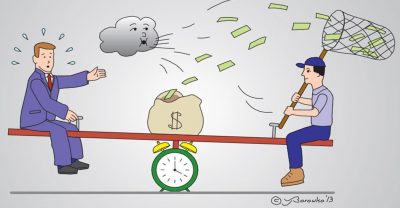Getting the Best Bang for Your Buck
 After Governor Baker’s Grand Bargain Deal was signed into place in August, minimum wage in Massachusetts is set to rise from $11.00 to $12.00 on January 1, 2019, on its way up to $15.00 by 2023. This comes with further changes to other benefits and may sound like a lot of money to shell out. We are here to tell you how to get the best bang from the new shucked bucks!
After Governor Baker’s Grand Bargain Deal was signed into place in August, minimum wage in Massachusetts is set to rise from $11.00 to $12.00 on January 1, 2019, on its way up to $15.00 by 2023. This comes with further changes to other benefits and may sound like a lot of money to shell out. We are here to tell you how to get the best bang from the new shucked bucks!
Employer Benefits of Employees’ Good Luck
Employees benefit from increased pay and benefits, but what do you get? Well, as it turns out, plenty!
Better pay and benefits can really boost employee morale and loyalty, as well as improve work attendance via ease of access to options like childcare, insurance, and prompt medical attention. It helps families—especially of three or more members—to afford safer, more secure lifestyles with improved quality and standard of living. An increase in minimum wage across the board encourages a culture of greater spending and business activity.
A sense of security can make all the difference toward happier, healthier, more productive and dedicated employees. Higher wages work against the issues of employee turnover and low productivity: higher-paid employees are more inclined toward long-term retention, harder work, and fewer mistakes. With better incentives and fewer turnover costs for recruitment, re-training, and re-staffing, employers can rest easier in offering longer-term trainings for employees more likely to stick around. In turn, workers acquire more specialized knowledge and higher-quality work.
Eileen Appelbaum and Annette Bernhardt summarized the issue with these words: “Workers gain with higher wages. Employers gain with higher productivity and lower turnover. And society gains when working families can provide for themselves and don’t have to resort to public benefits to make ends meet.” (1)
Money Isn’t Value, It’s Incentive
Joe Lineberry, senior vice president at Aon Consulting, puts it this way: “Give employees the benefits they value, and they’ll be more satisfied, miss fewer workdays, be less likely to quit, and have higher commitment to meeting the company’s goals. The research shows that when employees feel their benefits needs are satisfied, they’re more productive.” (2)
An increase in the productivity of employees would offset the newly-regulated increase in wages, thus minimizing the effect on cost and employment. Otherwise poor quality, low retention, and waning commitment can worsen operational problems and negatively impact business endeavors at every level of operations. Instead, with raises in minimum wage employers can enjoy the benefits without suffering a competitive disadvantage, as all companies within the field will be doing the same.
It’s worth remembering that an employee isn’t necessarily ‘worth’ the exact value they may be paid. If a business were to employ 5 employees at $12.00 an hour, there would remain a differential of return value: 2 employees may be worth the $12-14 an hour, while 1 may be worth $8 and the final employee somewhere in the $15-20 an hour range.
Solid benefits, higher pay, and smarter business strategies are leading signs that a company cares about its employees; these factors best predict an employee’s overall experience at a company, thus also their interest and commitment. But such benefits are expensive, right?
They don’t have to be. It may be time to change the focus on how to get the best bang for the buck.
Six Strategies of Smart Employers
Another option for return on value is to utilize the best options available for great management strategies: good employment policies (including Employee Handbooks detailing all policies, signed by each employee), solid job descriptions and trained talent acquisition managers, systems for reviewing and tracking employers’ performance (clear objectives, accountability, solid feedback in consistent reviews, and incentives), as well as general good management practices. These strategies save money and boost morale in the long-run and can encourage the highest value in each individual employee.
Here at the HR Engineers we suggest six tenants of Human Resource Management:
- Best Practices (for clearly-written policies and procedures, avoiding disputes, and keeping employees secure in their understanding of the rules and regulations);
- Labor Law Compliance (for avoiding federal and state fines);
- Performance Management (for insuring job expectations are met);
- Talent Acquisition (for finding and keeping the right people for the job);
- Benefits and Perks (for keeping employees and your accountant happy); and
- Training and Workshops (for developing skills and a well-informed team working together toward improved productivity and profits).
These strategies focus on having all pertinent information down in writing, training good hiring managers, hiring the right employees, investing in their long-term well-being and job skills, consistently monitoring progress and improvement, and getting the best value out of each employee through making them feel valued as employees. This can lead to a more equitable work-force of more personally-invested employees, a lower turnover rate, diminished training costs, fewer mistakes, and higher-quality work.
Who doesn’t want that in their business plan?
If you have any questions on how best to proceed or any inquiries regarding the words above or strategies to take, don’t hesitate to reach out to us here at The HR Engineers. We Help Employers Sleep at Night!
1] ‘Employers Also Benefit from a Higher Minimum Wage’ by Eileen Appelbaum and Annette Bernhardt, December 18 2004 [https://www.brennancenter.org/analysis/employers-also-benefit-higher-minimum-wage].
2] ‘Celebrating Work: Insights for Leaders Building Great Workplace Cultures’ by Rick Kiley, September 11 2015 [https://www.gthankyou.com/blog/employee-benefits-that-resonate-build-loyalty].